#repatriation of the body of a loved one
Text
With all the stuff about the Titanic submarine I keep thinking about the tourism of sites of mass tragedy and human remains. It’s a really important conversation that I haven’t seen many people discuss outside of historical and final care provider circles.
The Titanic is a grave. The only reason that submarines are even permitted to go through it is because it’s in international waters. Other shipwrecks, like in Lake Superior, are frequently declared grave sites and have restrictions or bans on exploration of their structure. At the very least, there should be incredibly strict restrictions on Titanic exploration. It should not be a tourist destination. There may be still be human remains in certain parts of the ship, and the mud around the ship is filled with corpses. Considering the tragedy only happened 100 years ago, this tourism is very disrespectful. Also, exploration of the Titanic could potentially damage the structure, which would hinder academic research as well as further disrespect the dead and those who remember them. The structure will not be around for much longer.
Tourism of sites of mass tragedy can also be very dangerous. Obviously we know why the Titanic is dangerous, but it goes beyond that. Oftentimes people are not aware of the danger, or are reassured by authority that it is safe. For instance, many people visit active volcanoes, and some have been injured or killed by eruptions. For some, the danger is a feature. There are people who visit Chernobyl, an even more recent site of mass tragedy than the Titanic, despite being aware of the danger of radiation. It’s thrill-seeking, but instead of a rollercoaster people are putting themselves in danger to walk through human remains.
Our natural fascination with mortality leads many to disrespect the dead. The viewing of human remains in museums is a big debate, and I personally don’t think that we should display human remains without previous consent from the person. Imagine how you would feel if yourself or a loved one was displayed in a museum, or had your resting place constantly disturbed by tourists.
It’s also important to note that this type of tourism disproportionately impacts people of colour. Eurocentric society systematically dehumanizes the bodies of POC, and this becomes crystal clear in how we treat their remains. Egyptian mummies remain on display in museums despite the disapproval of many Egyptian people. Many black bodies, particularly of women, have been displayed in museums, such as Saartjie Baartman who was finally buried in 2002. Indigenous human remains are also frequently displayed, and ancient burial sites are viewed as cursed land and get destroyed by construction. The remains of people across Asia have been sold and displayed, with recent displays posing the human remains of Chinese prisoners. Most human bones being sold originated from graverobbing the graves of Asian and Indigenous people. None of these people consented to this treatment, and these communities are still being harmed by the commodification of their dead.
Engaging with sites of mass death needs to be done respectfully. The dead deserve our care.
It’s natural to be curious about tragedy and death, and engaging with our own mortality can be healthy. There are ways to engage with these topics respectfully. Many online resources are available to learn about death, with my personal recommendation being the youtube channel Ask a Mortician. Visiting cemeteries is another great way to engage with death, so long as you abide by the rules and have good intentions. There are some great documentaries about instances of mass death, with many available for free on youtube. You can visit designated memorials of the sites. The Titanic itself has a section in a graveyard in Halifax. I also recommend donating to and supporting the efforts of communities to have their human remains and cultural artifacts repatriated.
Sites of mass death need to be treated with the same respect as cemeteries. They are important and full of education, but we need to remember that these are real people. The dead are not fantastical oddities; they are us.
245 notes
·
View notes
Text
Hiii guys! THEORY TIME
So um I've been thinking quite a lot about the new DS2 trailer, I rewatched it like 20 times and also the first trailer again and I wanna make a theory about the possible timeline of the second game + some other ideas in the middle. It probably won't be accurate at all cause Kojima's brain works in mysterious ways but hey, I wanna try cause I just keep thinking about it night and day.
So! The scenes in trailers aren't really in any order (duh) so I tried to figure out the timeline.

This scene. A lot of people were worried that there's no Sam here and is Fragile the one taking care of Lou? I would say that she's just babysitting. Maybe Sam had to leave for something (Go to town grab food, supplies, who knows, maybe it was all planned and someone orchestrated the whole situation so Sam would leave the base so he wouldn't be a threat.) Since Fragile is a person he trusts, he might have asked her to come by and take care of Lou. The place where Sam was cooking food in the 2nd trailer and the place from the 1st one looks similar, so I would say it's the same.
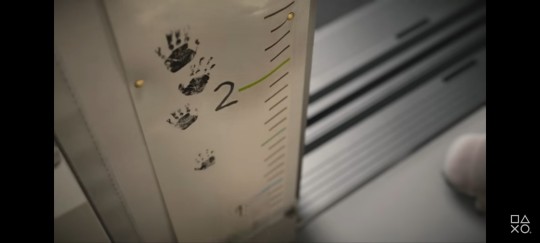
Listen, I don't know anything about little kids, so I used the internet. The measure here is in inches, and the first smallest handprint is at 18 inches. According to an article I read, newborn girls measure at around 19.4 inches, and Lou was still a fetus when she came out of the pod, so it makes sense she would be a bit smaller. The biggest mark it at 28 inches, and the same article stated that babies can grow 10 inches by their first birthday, so I would say Lou is around 1 years old when the whole attack happened. Is it relevant? Who knows.
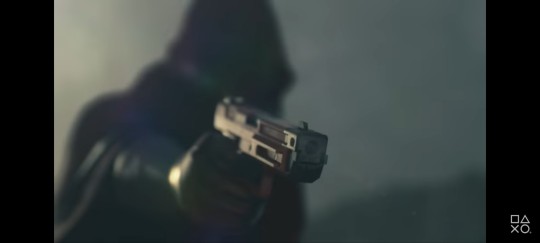
Then we have the whole this situation. By the look of this person, and the color of the gun, it appears to be red. Who else has everything red?
Higgs' lovely cult friends in black masks. I don't think its Higgs himself, it might be someone he send, but also it could he Higgs? I don't know.
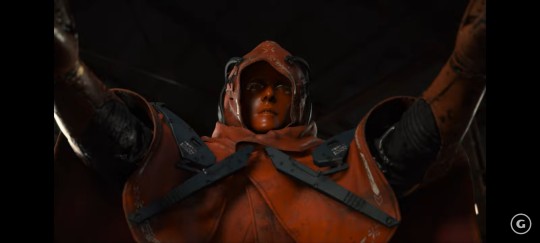
I mean, the hood, the everything, the golden shine on the hands that reflects in the light, his hands appear to be more smooth than fully robotic like the other guys? If you look very hard the crimson color is still there in the first photo, it just appears dark.
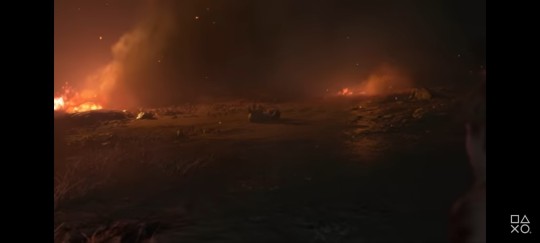
No clue what the hell happened here 😭 But there we see that Lou is on the ground and then she dies? I have a theory that Lou could be a repatriate like Sam. Sam became a repatriant because Amelie/Bridget ressurected him on the beach. If I remember correctly, Sam did the same to Lou when the crater exploded at the beginning of the game. That's why they both "survived it". It could be possible that because of that, Lou also gained the ability to become a repatriant. But what if something went wrong?

Here we see that Lou "appears" in the pod. But her silhouette looks very similar to a BT. BT's don't age. What if little Lou tried to repatriate by herself but by accident she split her Ha and Ka. Her soul ended up trapped in the pod, or near Sam, and her body was taken by Higgs/to Higgs. He wanted ravage from what was said in the trailer, and what better ravage than taking his beloved kid's life? It would hurt Sam way more than actually doing anything to him directly.
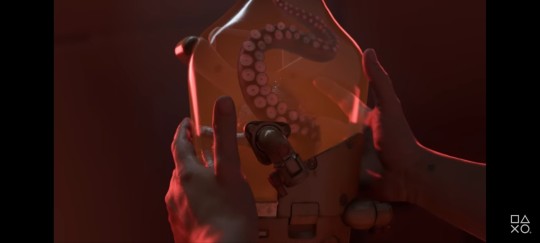
This is when Sam notices that Lou's soul is trapped in the pod perhaps. See the red lightning? It could be when Sam got back to his base.
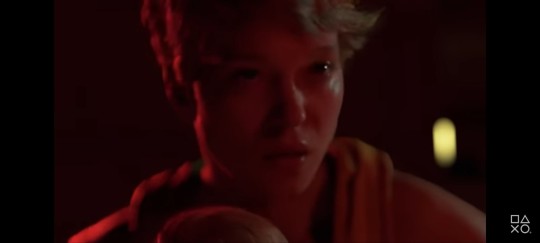
Since after the attack the lights in the base turned red.
If we look at the 2nd trailer more, we can see that Sam I walking with an empty pod, so he is aware that Lou's soul is in the pod, thanks to it Odradek can still detect threat. This is so interesting!
When Sam and Higgs meet and Higgs takes the empty pod in his hands, touches it and feels something, he's like, kinda in awe?

Then there's the big red cyborg ninja (lmao). It has Odradek's face and we already figured its "possessed" by Lou and tries to protect Sam. I've also seen a theory about Higgs calling himself a ghost and the Ghost in the machine thing, I forgot the user but y'all are genius 🙏🙏
If Higgs is a ghost in a machine, so his soul possesses the cyborg suit, then Lou also can posses a machine, right?
Also I wanna talk about the whole puppet thing and control stuff here because I have thoughts. I don't know if I remember everything correctly 100% so feel free to fix my mistakes, but in the first game Higgs was sort of Amelia's puppet, right? He was the tool she used to get Sam to her, a tool that would push Sam to go thru America and connect it, to connect all the beaches together so she could destroy the world, as it was her destiny. She have Higgs these crazy DOOMS powers. That's why I keep wondering if in the second game Higgs is still a puppet, or did he get tired of it and decided that this time he will be the puppeteer? We see the strings that are on older Lou, we see the strings of the robots that Sam fights with a gun, I'm wondering if Higgs is also pulling the strings of something much bigger.
What if Higgs is responsible for APAC? The private corporation, the patron that gave Fragile the money and tech for the ship? They apparently never saw face-to-face (Higgs' mask), Higgs has a factory with tech, he has all kinds of robots, weapons, he has to have money, and in the 1st trailer it's said that APAC made the final decision, whatever it means. If Higgs sponsors the whole thing, he can also make the decisions. But that's just the thought that I had.
Also the "chrysalis" in which Lou'a body was in kinda reminds me of the sarcophagus in which Higgs was in, just a thought.
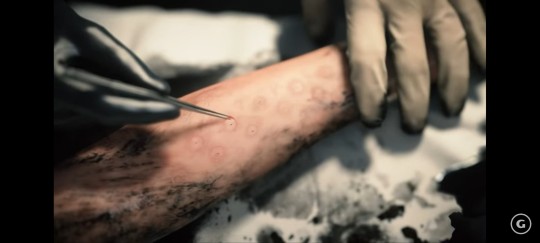
Also these weird ass trypophobia inducing things on Lou's arm remind me of the octopus' suction cups on their arms. It's quite similar to the octopus arm in the pod in one of the photos above.
Alright, that's it for now!!! I have no brain cells left, I probably didn't write everything that I wanted cause I forgot, but tell me your ideas if you want, I would love to read your theories!! Does any of it make sense? I don't care because it's a Hideo Kojima game so common sense or any other kind of sense doesn't apply 😍😍
I love analysing this shit it's like crack with some other good stuff
#death stranding#higgs monaghan#death stranding higgs#death stranding 2#ds2#death stranding 2 on the beach#death stranding theory#sam porter bridges
19 notes
·
View notes
Text
A few things I've been thinking about and find subtle links to Death Stranding
Chakras and Death Stranding
This text has content that I took from a book of Reiki handouts that my mother has, so the view of Chakras here is from the viewpoint of Reiki practice.
Chakras are round energy centers and in the East they are seen as whirlpools of energy, little cones (funnels) of spinning energy. They are large, shiny and translucent and, in normal human beings, have a diameter of five to ten centimeters, reaching 20 centimeters in diameter in spiritually developed people.
The size of the Chakras varies according to our energy and spiritual development and can vary according to the individual's energy (positive or negative energy). And each Chakra resonates with a color that derives from its vibration frequency. Each one vibrates with a sound or mantra that corresponds to a musical note and also relates to a natural element: earth, water, fire, air and ether.
In the Oriental view, each Chakra is represented by petals like flowers, depending on the complexity of each one. Ancient writings mention that we have up to 88,000 Chakras throughout our bodies, in other words, we have countless energetically sensitive points, but most of them play a secondary role.
But let's just talk about the 7 main Chakras through which the human aura is connected.

source
The Chakras are responsible for the energy flow in the human body and their main function is to absorb prana, which is the energy coming from the Sun, metabolize it, feed our aura and, finally, emit energy to the outside.
Knowing this, let's talk about Death Stranding, we know that Sam, when he dies in his baby phase, is repatriated by Amelie in his Beach. Amélie "seals" Sam's body with a mark and brings him back to life, causing Sam to gain a peculiar scar and live around without a navel. We're talking about the Umbilical/Sacral Chakra here, and according to the Reiki view this is the second Chakra.
We're going to talk about the other two Chakras that, for me, were also "affected" by the repatriate/shot mark, but let's start with the Umbilical Chakra first.

Name: Svadhishthana
Location: Navel area
Color: Orange
Auric body: Emotional
Element: Water
Music note: D
Mantra: Vam
Number of petals: 6
This chakra is for the propagation of the species, in other words, reproduction. Its correct activity makes us love life. It is the Chakra that concentrates the qualities that have to do with sexuality, curiosity, the creative search for material pleasure, a taste for beautiful things, art, emotions and relationships with other people. This chakra is the seat of fears, ghosts and negative fantasies linked to sexuality and behavior towards another sex. If it malfunctions, it can turn life into a small personal "hell" which ends up being reflected in the people we live with and relate to.

Blockages in this Chakra usually result in physical symptoms such as illnesses related to body fluids (larynx, lymph, saliva, bile). Blockages in the sexual center often result in mental symptoms such as fear of physical proximity and disgust for the body, a mania for cleanliness, incomprehension, a mind that is too focused on reason, an excessive emphasis on impulsive feelings, rhythmic disorders, isolation, frigidity, impotence, lack of sexual appetite, fear of falling.
This Chakra together with the first are important and if they function incorrectly the other Chakras won't be able to function properly either.
I could say that due to the size of the damage caused by the shot, not only the Umbilical/Sacral Chakra was affected, but also the Base Chakra(#1) and the Solar Plexus(#2), because all three are located exactly in the center of our body's balance.
So let's look at a basic summary of the other two Chakras (first and third) to complete the analysis.
-> Basic Chakra (first)
Name: Muladhara
Location: Base of the spine
Colors: Red and black
Auric body: Etheric and physical
Element: Earth
Musical note: C
Mantra: Lam
Number of petals: 4
It lies between the anus and the sexual organs, on the line of the pelvic girdle. This chakra is open downwards and represents the human being's connection with planet Earth, with the material and physical world. It is linked to our earthly existence, our survival. The more open and elevated this Chakra is, the higher our physical energy (disposition) will be.
-> Solar Plexus Chakra (third)
Name: Manipura
Location: Mouth of stomach
Color: Yellow
Auric body: Mental
Element: Fire
Musical note: E
Mantra: Ram
Number of petals: 10
It represents the personality and concentrates the qualities of the rational and personal mind, vitality, the will to know and learn, the action of power, the desire to live, communicate and participate. It is the point of connection with other people. This Chakra is the one most closely related to our ego and therefore absorbs a lot of energy from the first two Chakras.
In summary, I find it interesting how I could find a little sense in the location of the Chakras in relation to Sam's injury, and in relation to what the mark of the repatriate represents for him. I don't know if Kojima did this consciously, but there is something that makes sense, for sure.
The center of the human body (CORE)
One of the funniest things for me was realizing that they chose Sam, a guy who doesn't have his "center" complete because of a brand. In other words, metaphorically speaking, Sam has no "balance" at all because his center has been "affected", and yet he is the Man Who Delivers, the guy who stacks things and needs to have good balance and core strength to do what he does.

How to "close the body" to negative energy
In my religion we say that if you want to go somewhere or meet someone and you want to protect yourself from any negative energy that the place or someone might inflict on you, you just have to wear an adhesive plaster on your navel, so this symbolic action will protect you from negative energies, because that's where we receive and donate energy, so it's an open field. There is the possibility of something or someone sucking this energy from us consciously or unconsciously, just as we can lose this energy unconsciously too.
This doesn't literally mean having a closed body, because the expression can mean another type of ritual that leads us to literally close the body, something much more complex than just "covering the navel", but technically it can be said that this is closing a door to things that can affect us.
14 notes
·
View notes
Text

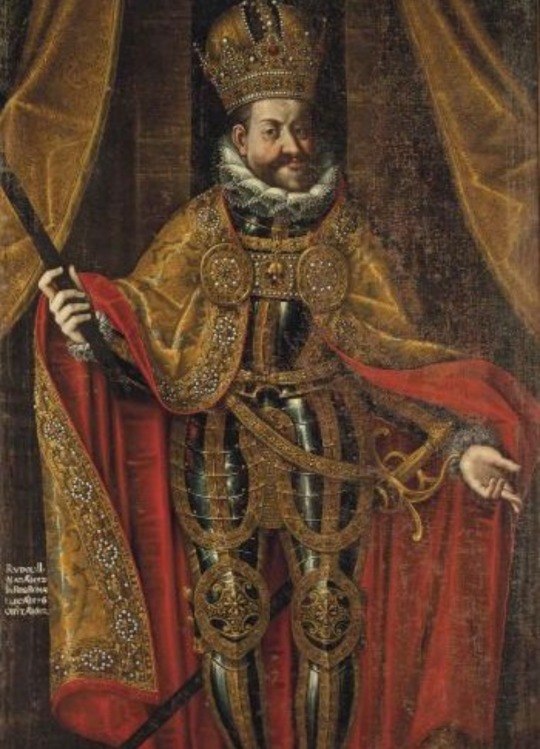
To be honest, this has been harder to theme since Franz Joseph lost his quarterfinal. So here's what I've got: look at these (allegedly) bisexual weirdos. No one produces bisexual art and science bitches quite like this dynasty.
Maximilian , Emperor of Mexico, reign: 1864-1867
Rudolph II, Holy Roman Emperor, reign: 1576-1612
Propaganda under the cut:
Maximilian
From: anon
- He loved plants
- He was a sassy man
- He had good taste
- He learned Nahuatl
- He’s cute (I mean look at him)
- He said “gay rights”
- He banned child labour in Mexico
- He gave many rights back to indigenous people
- Bro was wronged by France (haven’t we all?)
- He’s baby
- Got executed, come on, give him this guys 🥺
- He loved to design gardens and collect insects which makes me think he would've loved playing animal crossing
- An outspoken liberal in a period where the monarchy was still quite conservative.
- Vice-Admiral of the Navy who initiated scientific projects and exploration.
- Aesthetic girlie. Collected flowers, painted, wrote poetry, and kept a journal. He would have loved Tumblr.
- (Probably) gay or bisexual.
- Allegedly slapped Franz Joseph for refusing to allow Lombardy to have an elective body.
- Sisi's favorite brother-in-law (and not in a romantic way, fuck you Netflix)
- Refused to take the Mexican crown until a plebiscite had been held because he wanted to be invited by the Mexican people.
- Gave up all of his Austrian titles to go to Mexico because he believed he had made a promise to them.
- Also, his wife was amazing and capable and the amount of pure misogyny that certain historians and biographers have thrown at her is ridiculous. I know this isn't a Carlota poll, but she'd want Max to win.
- Netflix did him unbelievably dirty. Please give him this.
Did you know my man Max repatriated many pieces of Mexica artefacts?
He told Austria to cough up 3 main things that he thought were rightfully Mexican.
1. The Chimalli
2. A codex
3. A letter from Cortez to the chocolate man people seem to call Charles
The Austrians took their time but eventually gave back something
The Chimalli next to max so people know who to thank for it

Rudolph:
- Possibly neurodivergent girlies rep also!!
- - THE ABSOLUTE BICON 💗💜💙
- Contributions to art and science!!! Alchemy, astronomy, painting etc flourished in his court we literally have some of the most beautiful baroque artefacts because of him
- Where do you think that pretty little crown in the polls icon came from
- Would rather do that than politics so real king
- Accused of doing occult? He's THAT astrology witchblr bitch
- VERY misunderstood and poor little meow meow uwu everyone thought he was incompetent and horny and cray cray like it was a bad thing
- We've voted on twinks? BEARS need love too!!! 💅
- Would've LOVED tumblr tbh he walked so all of us today could run 🩷🩷🩷
The fun portrait:

29 notes
·
View notes
Text

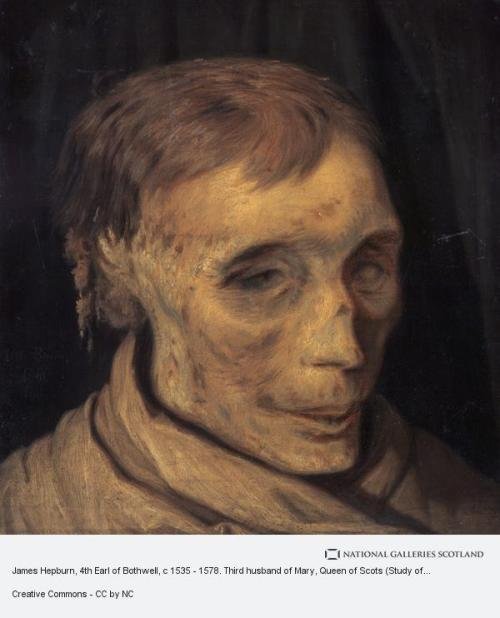

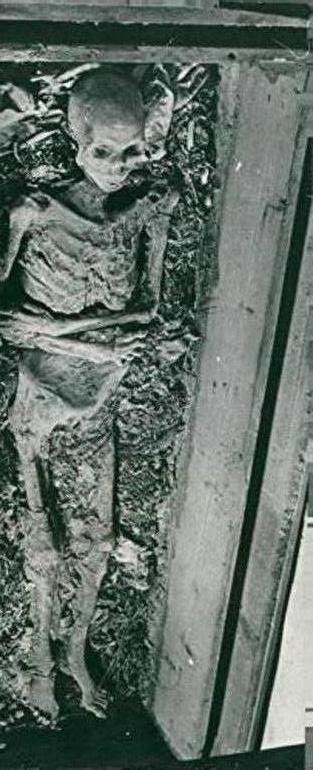
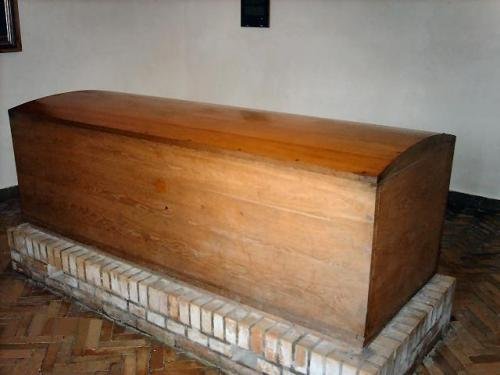
On April 14th 1578 James Hepburn, 4th Earl of Bothwell , Earl of Orkney and third husband of Mary Queen of Scots died, aged 44, tied to a post in a dungeon at, Denmark.
As I posted on Friday Bothwell fled Scotland after the surrender at Carberry Hill, Queen Mary’s last act of love for him was guaranteeing he could leave the area unharmed.
Bothwell took ship from Aberdeen to Shetland, he may have stopped off in Orkney, the only thing we know is he was denied refuge there and travelled on to Shetland.
He was pursued by Sir William Kirkcaldy of Grange and William Murray of Tullibardine who it seems were not that far behind him. They sailed into Bressay Sound near Lerwick. Four of Bothwell’s ships in the Sound set sail north to Unst where Hepburn and his cousin, the pirate, Olaf Sinclair were negotiating with German captains to hire more ships. Kirkcaldy’s flagship The Lion, chased one of Bothwell’s ships, and both ships were damaged on a submerged rock.
Bothwell sent his treasure ship to Scalloway and fought a three-hour-long sea battle off the Port of Unst where the mast of one of his ships was shot away. During the chase a storm erupted and Bothwell’s superior seamanship to come to his rescue. After transferring his men to his two remaining ships, he sailed south-east before the wind, making the 250-mile crossing in record time Although Kirkcaldy followed for sixty miles, he was out-sailed and, by his own admission, was ‘no good seaman’.
He might have thought he was off the hook again, but no, Frederick II was not sympathetic to his cause, he was at war, and was torn between his blood ties to Mary Queen of Scots and the need to show loyalty to his Protestant allies. Fortunately for him, the problem solved itself when Mary, held prisoner in England, dissolved her marriage to Bothwell, making him merely a problem to be got rid of from Frederik’s perspective, so he ordered his arrest to be used as a bargaining chip in the forlorn hope that he would be traded in return for the return of the Northern Isle!
After being brought before the Bergen magistrates, in September he was carried to Copenhagen on one of Frederick’s ships for ‘honourable confinement’ at Dragshorn Castle, the Scandinavian equivalent of the Tower Of London. I found an extract from My Heart is My Own, a biography on Mary Queen of Scots that reads
“On 14th April 1578, Bothwell died at Dragsholm. As was customary for state prisoners, his body was carried to the promontory that juts into the fjord a side of things. mile or so from the castle and buried at the parish church of Fårevejle. (…) “
There are differing versions on how he lived out his last days, one says he was actually not held in ‘honourable confinement’, but in a small dungeon chained to a post, the cell so small he was unable to stand, the second is more in the line of the ‘honourable confinement’ that he spent the last years drinking to excess with others held at the castle and gradually became more and more insane.
John Maxwell, visited Dragshorn Castle, and reported that Hepburn had latterly become overgrown with hair and filth. I take it from this he was still alive at the time!
The story doesn’t quite end there, Bothwell’s coffin was opened for the first time in 1868 and a very well-preserved body was found, which subsequently rapidly decayed and, for a period of time, until 1973, was open to public viewing under a glass lid. Then, in response to a request from the descendants of the Hepburn family, the newly-crowned Margrethe II had Bothwell buried in a zinc-lined coffin within a sarcophagus of oak, and here he remains.
Every now and then there is a story in the press about his descendents making an attempt for his body to be repatriated, I have no idea why the Danes would not allow this and for the moment he remains there. Of course with a story like this the castle is said to be haunted by the "good” Earl, where is he said to ride through the courtyard with a full horse and carriage.
The pictures are, the supposed head of Bothwell “ Study of Mummified Head” by Danish artist Otto Bache. The even more gruesome “body of James Hepburn” although the church where his supposed remains lie was known to have exhibited several bodies over the years as his, therefore, it is impossible to know if this is actually him.
There have been moves by his descendants to have his body repatriated through the years Speaking in 2010 Sir Alastair Buchan-Hepburn, Bothwell's direct descendant sought to raise funds to lobby the Scottish and Danish governments, saying "I want the Scottish culture minister to get in touch with his Danish counterpart to ask him 'would you please consider to return the body of James Hepburn, the Earl of Bothwell?'"
James Hepburn, 4th Earl of Bothwells’ remains are now kept in the crypt at the church at Faravejle, near Dragsholm Castle, as seen in the last pic.
7 notes
·
View notes
Text
3k Rec list
I’ve been meaning to do a rec list forever, but I am, unfortunately, very disorganized SO HERE ONE FINALLY IS
The Queen of the King by @gav-san : Once every one hundred years, a King is born to the Gerudo, and this king is required to find a Queen of a different race. In order for this stubborn king to find a bride worthy of his ambitions, he comes to Hyrule, under the guise of renewing the treaty between the two lands. Unfortunately for you, he quickly finds the one woman for whom he is eager to wage a war over. (Ganondorf x Reader)
Rise With Me by @ro-blaze and @kaelsmiscellany : “One sits, wings broken, yearning for what she can no longer understand. One stands, fire raging, burning with righteous fury over what has been stolen from him. Two bound souls separated for millennia meet once more, a fragile hope to heal the rift between their broken kingdoms.” (Ganondorf x Zelda)
Blood Moon Rising by MissGilette (AO3) : The orphans living at The Sanctuary worship the angry god dwelling in Lake Hylia. Every year on the night of the blood moon, one of them is sacrificed to appease the god. Link is a non-believer due for a rude awakening. (Link x Sidon)
A Light Down the Well by TheLongRoadHome (AO3) : The Calamity struck 100 years ago and the Zora were wiped from the face of Hyrule before Princess Zelda and Champion Link could meet them. King Dorephan was felled by Ganon. His body and the death of his people displayed; so all might see the futility of resistance against the Blight.Now Link and Zelda have conquered the Calamity, and the repatriation of Hyrule Castle begins. But there’s something else still lurking in the castle, waiting for Link, and it’s angry. (Link x Sidon)
Interim by starkraving (AO3) : She has no throne. Girls without thrones should not have knights, but hers won’t go. Princess Zelda – the girl who killed Calamity – would love to fade into legend, but Link’s bought a house, he’s fighting off monsters, and he’s selling giant horses to strangely familiar Gerudo men. She'll never have any peace now. (Link x Zelda x Ganondorf)
Drowning in You by @pinkchubbiebunnie : Spending the summer working as a lifeguard at Hawkins Pool with Billy Hargrove was probably something most girls would kill for. You - you were mostly just lucky that you hadn’t killed Billy yet. Until one day… when wanting to kill him became something else entirely. Something very dangerous, and very beautiful for the both of you. (Billy Hargrove x Reader)
As The World Falls Down by Fangedwoman (AO3) : You've left your home and everything you've ever known and suddenly find yourself in and then out of a mysterious forest. You find yourself forging new friendships, building a life from the ground up and fending off confusing new feelings, all under the watchful eye of The Goblin King. You just wish you knew why he kept his gaze so unwavering when it came to you... (Jareth x Reader)
A Prince of Dathomir by @kimageddon : When her childhood friend was stolen from her home, from her life by a monster in a black cloak, Nightsister Zaiya Valessa is filled with a rage and determination to do anything in her power to get him back and reunite him with his brothers and his family. To take his place as the Prince of Dathomir. No matter who or what stands in her way. (Maul x OC)
The Kings and their Queen by calamityqueen (AO3) : To say that you didn’t harbor feelings for Maul and Savage would be a complete fallacy. At first, there was nothing but a friendly business relationship between you and the brothers, but it soon festered into something more. The flirtatious banter, smoldering gazes, and lingering touches that occurred throughout the day stayed with you in the night, and caused an ache in your core. But you couldn’t possibly choose between the brothers— you loved them both too much to be forced to pick— so you had resolved to keep your feelings for the sith lords secret. (Maul x reader x Savage)
#fic recs#ganondorf x reader#ganondorf x zelda#sidlink#zelgan#ganondorf x zelda x link#triforce#Billy Hargrove x reader#maul x reader#jareth x reader#savage x reader
244 notes
·
View notes
Note
(genuine question) Would you mind explaining what the problem is with selling human bones? I'd never really thought about it before your fact check on that airbnb disinfo post started circulating and I'd love to hear your thoughts.
I could see it being a matter of respect or consent in general, commodifying bodies of POC specifically, but I don't know anything about the industry, where these bones come from, or what the major ethical issues are. I don't really understand what's different there vs. what I consider generally accepted disturbance of human remains like in archaeology.
Oh sure, keep in mind that I am not an expert! and I'm talking about a western capitalist context for the treatment of human remains and therefore don't have any say in (for example) cultures where the treatment of the dead is different, i have not education or right to comment on that.
to repost what i later replied to the post with:
actually i'm not done, the following are about a different bone seller from the last couple years but it goes over the ethical issues around sourcing human remains
youtube
the short version is: historically and in the modern day much of the human bone trade comes from exploitation of slaves and people in lower castes and so on to the point where even if it is a retired medical model or something inherited it is most likely to be remains acquired without consent of the deceased or their families. Repatriation where possible is the most ethical solution. We do not live in the ideal world where every human skull on the market is like that guy who donated his body to science and became yorick in Hamlet for the royal shakespeare comany. acknowledging the long history of grave robbing, racism, and exploitation in the medical industry and coming to grips with the same disregard of autonomy in death and disrespect in the modern bone trade is all i'm trying to draw attention to.
use artificial replicas in your decor! or try to find animal remains that are sold from roadkill and other natural causes! you can be macabre without [gestures vaguely at the above]
so in a context of people selling human remains to use as decor for profit, that in itself would be less of a morally weird thing to do if the deceased had in any way intended that for their remains (theoretically i'm sure some people would find the concept very cool) but that's just not the reality of these remains. It is very difficult to legally chose how you wish your body to be handled after death if it diverges from the norm, I would point to ask a mortician's video about human composting to show how recent (december 2022) something like that was legalised.
The reality is it is not a market with ethical procurement, the closest it gets is being a primarily second hand market. But the sourcing issue still remains
and the topic of when something goes from archaeology to tampering with the dead is a controversial one but if you want my opinion on that then i would point precedents like the Native American Graves Protection and Repatriation Act, or to this news story
To be clear, i am not anti archaeology or against a celebratory fascination with the morbid. I am very much for demystifying the process of death. But i think that there is too much pain and exploitation and dehumanisation and objectification and commodification of people throughout history and into the modern day. We do not have the ideal reality of all human remains in circulation being willing donations. I am personally for an active process of removing remains from a commercial market, identifying their origins, and repatriation and burial where possible.
obviously exploitation will always happen, legally or not, but while i may personally feel like personhood ceases post mortem i also believe in the autonomy of the living over their own remains (whatever that might mean) and that people don't deserve to see their ancestors and kin commodified in death.
and remember that legally and widely accepted things are not always ethical.
44 notes
·
View notes
Text
Since the beginning of Russia’s full-scale war against Ukraine, tens of thousands of people have died on both sides. At least three times more Russian soldiers have already been killed in Ukraine than in the entire Soviet–Afghan War, which lasted 10 years. International humanitarian protocols dictate that the remains of the dead be returned to their families. However, despite huge losses, reports on official exchanges often speak of only hundreds of bodies, leaving thousands of people unaccounted for. Russia’s brutal invasion is plowing through densely populated areas, leaving behind immense casualties. In dangerous conditions and with an overwhelming number of dead, bodies are often temporarily buried under a thin layer of earth. Ukrainian law calls for their exhumation, autopsy, identification, and permanent reburial or repatriation. This daunting work falls to special police units, volunteer organizations, and international humanitarian workers. The independent newsletter Kit published the story of how they go about this work in the face of an ongoing war and what is done with the bodies of Russian soldiers found on Ukrainian soil. Meduza is publishing an abridged English-language version of that article.
This article was written by a Russian journalist who chose to remain anonymous for safety reasons. The author has long been involved in battlefield archeology and has worked with groups currently searching for deceased military personnel in Ukraine.
An unimaginable toll
As Ukraine grapples with the devastating impacts of an ongoing war, accurately tallying the number of dead becomes a near-impossible task. Both combatants and civilians have paid a dear price, though the full extent remains shrouded in ambiguity and obfuscation. Both sides conceal their casualties, and civilian deaths are hard to estimate while cities and villages are still under fire and/or Russian occupation. Still, a semblance of the scale of loss is slowly emerging.
According to open-source data collated by BBC News Russian, Mediazona, and a team of volunteers, Russian military fatalities stood at around 35,780 as of November 3, 2023, excluding casualties from the self-proclaimed Donetsk and Luhansk “people’s republics” (DNR and LNR). However, this figure is almost certainly a significant underestimate, as not all military funerals are public. Having cross-referenced these names with inheritance data, Meduza and Mediazona estimated the real number to have already been close to 47,000 as of last May. Adding in an approximate 20,000 from the DNR and LNR, the military death toll on the pro-Russian side may well exceed 70,000. U.S. military intelligence places it even higher, at a staggering 120,000.
The situation is no less complex on the Ukrainian side. Official statements last made in December 2022 reported 13,000 military deaths, but this is likely an undercount. Independent assessments vary wildly, with figures ranging from 17,500 to as high as 70,000.
Beyond the military losses, civilians have suffered immensely. The U.N. has documented over 9,500 civilian deaths, including 545 children. However, this number only represents confirmed deaths, leaving many people unaccounted for. Ukrainian authorities list an additional 24,000 as missing. Yuriy Belousov, who heads the war crimes investigation department at the Ukrainian General Prosecutor’s Office, believes the civilian death toll could exceed 100,000. It is his office that is charged with the daunting task of exhuming and identifying Ukraine’s dead and returning their bodies to their loved ones.
The search
“The thing that really gets to you is the watches. More often than not, the hand ends up being higher than the body, so you find it first. And there, on the wrist, is a watch. You look at it — and it’s still ticking. It sends a shiver down your spine. The person is gone, but their watch is still counting time for them,” says a member of Black Tulip, a volunteer organization that has been involved in searching for, exhuming, and identifying the war dead in Ukraine since 2014.
Under the Geneva Convention, the controlling party in a given area is responsible for protecting the dignity of the deceased: identifying the bodies, if possible, and providing a proper burial or repatriating the remains, if requested. Relatives and relevant officials must also be given access to the burial site. Ukrainian law requires that all unofficial graves be exhumed and the remains properly reinterred. This isn’t just about identification — it’s a public health issue. Temporary graves are shallow, vulnerable to disturbance by animals, and pose the risk of contaminating groundwater.
The task of finding and exhuming these graves in Ukraine falls to the police, supported by volunteers from Black Tulip and international humanitarian workers, including teams from the International Red Cross. The bodies are then taken to the morgue for autopsy and forensic examination, which is overseen by the prosecutor’s office. This is dangerous, meticulous work, often conducted under the threat of rocket fire and drone sightings. The bodies themselves may be booby-trapped or lying next to unexploded ordnance and tripwire mines. But it serves a crucial purpose: ensuring dignity in death for the victims of the conflict and helping to piece together evidence documenting war crimes.
Since the onset of the full-scale war, Ukraine’s forensic infrastructure has been struggling to handle the increased workload. Rapid shifts in the front line only make things worse, as retreating forces often don’t have time to retrieve the dead and critically wounded, and some military personnel, such as scouts or those caught in artillery shelling, are never found. In the first months of the full-scale invasion, there were numerous photos on social networks and in the media showing bodies abandoned in fields — the grim aftermath as Russian troops pulled back.
Temporary burials by relatives or acquaintances are comparatively easier to find, but often the dead are buried by strangers. Even if a makeshift grave was marked, improvised crosses are frequently destroyed by explosions or blown away in storms, and plaques are eroded by the weather. Bodies left in trenches are even harder to find, as the earth slowly covers them up.
To locate the dead, search groups survey the terrain for telltale signs of burial, such as ground subsidence, fresh pits, and clearings, and talk to local residents. Dogs help comb through rubble of bombed residential buildings, and drones and satellite images are increasingly being used for search purposes, especially for inaccessible areas along the front line. Operators record the exact coordinates of bodies and pass this information on to the police and, when the territory is liberated, specialists go to the sites. It was satellite imagery that helped locate a mass grave in Izyum that appeared during Russian occupation.
Workers use an old but proven technique to check for bodies: probing with thin metal rods that easily penetrate the ground. If they hit something, the expert taps, listening for the distinctive sound of bone. When remains are found, they’re exhumed and all details, from clothing to dental work, are meticulously documented to help with the identification process.
Black Tulip volunteers play a vital role in the search process. They have vast experience in such tasks: since the early 2000s, members have searched for, exhumed, and identified the bodies of World War II soldiers in Poland and Ukraine. In 2014, Black Tulip was the only Ukrainian search group allowed by the self-proclaimed DNR and LNR authorities to cross the front line and retrieve the bodies of Ukrainian soldiers. From 2014 to 2018, they brought home the bodies of over 800 servicemen.
Currently, Black Tulip has around 100 volunteers. Since the onset of the full-scale invasion, they’ve exhumed over 300 bodies. “We’re volunteers, not soldiers, so it’s less risky for locals to inform us about the bodies,” says one of the members. He adds that the organization knows of dozens of unexamined mass graves in occupied territories.
International protocols recommend ground teams work in two-week rotations and receive psychological support and rest between deployments. However, in war conditions, this is hardly feasible. The work is grueling, lasting as long as there is daylight, and emotionally taxing. One Ukrainian police officer described the impact: “Sooner or later, the weight of what you’ve seen takes its toll. After all, you’re finding people, not mere objects. Some stories are impossible to forget, and there are quite a few of them. But there’s hardly anyone to talk to about it, and I don’t really want to.”
Identification
To identify the bodies, experts look for dental work, fractures, signs of past operations, tattoos, moles, or anything other unique detail that might set the person apart or help someone recognize them. They use DNA analysis and fingerprinting, as well as facial recognition and reconstruction software. If the person has a photo ID or military tag, this can simplify the process. But in wartime, soldiers often strip bodies of any identifying items to obscure their unit’s affiliation.
Even if the person had documents on them when they died, this isn’t enough for an official identification — a relative has to recognize and claim the body. Sometimes, this is impossible. Family members may have left and be unable to return, or the entire family may have been killed together. If bodies remain unidentified and unclaimed, they’re buried in designated sections of city cemeteries.
DNA is the most reliable way to confirm someone’s identity, whether through comparison with official records or with samples given by relatives. Ukraine’s DNA database has become one of the largest in the world, with over 45,000 new records in just the first six months of the full-scale war.
Bodies aren’t exhumed just for identification; it’s important to find the cause of death. The nature of a person’s injuries and items found in their bodies (such as bullets or shell fragments) can become evidence in war crime cases. For example, the bound hands of civilians shot and dumped in hasty graves near Izyum show that these people were executed.
Once bodies are exhumed, they’re taken to the morgue. Forensic teams have to work amidst power outages and air raid alerts, and in winter, without heating or functioning refrigeration units, as Russia bombs Ukrainian thermal power plants. Ukraine’s morgues, especially near the frontline, are inundated, necessitating the use of railcars and mobile containers as makeshift cold storage. At the beginning of the war, Ukrainian Railways allocated 20 railcars for this purpose, each able to hold up to 90 bodies.
“We definitely need help from international partners. […] Our system wasn’t ready for such a huge number of unidentified bodies,” said Belousov at the beginning of 2023. And help has arrived — now forensic experts from France, the Netherlands, Switzerland, and the United Kingdom are working in Ukraine, as well as the International Commission on Missing Persons and the International Committee of the Red Cross (ICRC). The latter has been working in Ukraine since the beginning of the war in Donbas in 2014. ICRC staff train specialists in working with remains and help return bodies from both sides to their home countries.
New technologies have also made the identification process easier. In March 2022, the Ukrainian Defense Ministry announced that it was using Clearview facial recognition software, which compares images to a database created from publicly available photos. But experts have their doubts about this type of identification when dealing with decomposing bodies, especially with bloating. Photo databases of the dead can also be used in psychological warfare if there’s a leak. Relatives of dead soldiers on both sides of the war sometimes receive threatening or debasing messages. Pavel Kravchenko was a soldier from Russia’s Irkutsk region who went missing. His girlfriend was sent pictures of his mutilated corpse, along with messages saying: “Come get your corpse or we’ll burn it. He died here like a dog. He went to kill children.”
Exchange
Just as doctors must treat all wounded, government workers and volunteers handle bodies from both sides. When Russian soldiers die in Russian-controlled territory, they’re taken to a processing center in Rostov-on-Don. But Russians often learn of their loved ones’ deaths on the Internet, including from photos uploaded to Ukrainian social media groups, rather than from the military.
If a Russian soldier dies in Ukrainian-controlled territory, the body is sent to the city morgue until an exchange is agreed upon. “We act humanely. Our task is to remain human in any situation, and that’s what we do,” said Oleksiy Yukov, a Black Tulip volunteer. Because Ukraine doesn’t have a database of Russian citizens’ DNA, analysis can only be performed after a transfer. Exchanging the dead, though, happens quite rarely, as it hasn’t been possible to establish a permanent negotiation process between Kyiv and Moscow. Informal agreements on the front line only work in isolated cases, and formal agreements take an excruciatingly long time — in one case, a year and a half.
There isn’t much information about the negotiations; details are kept secret. Certain bodies, like those of officers, special forces, and pilots, are usually considered more valuable and can be exchanged for several rank-and-file soldiers. Sometimes, bodies are exchanged for prisoners of war.
The Red Cross helps organize negotiations and facilitate exchanges, which usually take place in a neutral zone. From there, bodies are delivered to the nearest hospital or morgue. A deceased Russian soldier usually goes from a Ukrainian morgue to a morgue in occupied Donetsk or Luhansk, and then to a morgue in Rostov. There, DNA samples will be taken and, after a match is found, the body will be given to the family for burial. In March 2023, Ukraine said that since the start of the full-scale invasion, it had returned the bodies of 1,426 Russian soldiers. Current data shows the number has now risen to 1,991.
The Russian side has never reported the number of bodies transferred or received. The last exchange took place on August 29, 2023. Ukraine was given the bodies of 84 deceased military personnel, but how many bodies the Russian side received is, once again, unknown. According to an estimate given last February by Sergei Krivenko, head of the human rights group Citizen. Army. Law, at least another 25,000 Russian soldiers may be missing in action.
Forensic anthropologist Photis Andronicou from the International Commission on Missing Persons believes that it will take decades to identify everyone who died in Ukraine, even if the war were to end right now. People will be searching for their loved ones for many years to come — without knowing how they died and without the opportunity to say a proper goodbye.
7 notes
·
View notes
Note
Does she know how lucky she is of the people she found and her persistence, deep down?
Warning: Talks about self-harm
Anon, I seriously love you and your asks
Riot is very aware that if it hadn't been for her two sets of grandparents, she wouldn't be alive. It was a struggle, but most days if she got out of bed and the house was to not disappoint them.
When she lost the last of them, right after her parents, she went off the deep end. She dropped out of college. She had to deal with lawyers, repatriation of her parents' bodies, burying her grandpa, cremating her parents, paying fees, dealing with her parents employers, etc etc and she broke.
She jumped off a cliff. Obviously, she survived, instincts kicked in and she swam back to shore. Then she decided to enlist (she always wanted to, but her parents were completely against military in spite of both her grandfathers being military)
And in the military she met Soap, and he became her anchor, her only family. Sometimes she feels guilty because their friendship is so deep and strong that she feels like a burden, like she is preventing him from finding someone (not everyone would deal with their SO having a best friend like they are). Soap's sisters and parents 'adopted' her, and she slowly started to feel human again. She is endlessly thankful to them, especially to Soap, Mini and their mother.
Things went to shit when Soap was recruited by Price and she had to go somewhere else, and then to HeadHunters. The only highlight was her friendship with Laswell, and her squad (Phoenix). They were the only good people in a unit of bastards, and although it wasn't ideal, it was better than nothing.
And then, Transnistria (THE thing). She tried to cut her throat while in captivity, but wasn't successful. And she did terrible, bloody, violent things to escape.
Laswell wanted to tell Soap at least, but Riot refused. She didn't want him, or Mini or their sisters or mother to see her like that. During MW2 she was in hiding, and being taken care of under a false identity thanks to Laswell.
When Laswell sent her the text telling her she had a job interview with Price, she was sitting on a beach, considering swimming into the sea and never return.
One of her trainers at Hereford said she was too stubborn to die. Riot, the bulldozer.
She is aware that she is terribly lucky to be in the 141, and cherishes all of them more deeply than any of them know. Not even Soap knows how responsible he is of her still being alive.
And also, because she is fucking stubborn.
4 notes
·
View notes
Text
So I finished Golden Age and Other Stories last night (is there a paperback edition? I'd love to have a physical copy for my shelf) and of all the little drabbles at the end, the one that caught my attention the most was the bit about Lien at a nightclub in Paris ordering Absinthe.
I found it intriguing and it generated a bunch of questions for me that I'd love to see expanded on someday.
How long after the events of League of Dragons does this take place? In our timeline, Napoleon passed away in 1821 but his remains were not repatriated back to France until 1840 and the tomb at Les Invalides not actually completed until around 1860. You would think Lien would return with Napoleon's body in 1840, but the conversation with the part-Incan dragon bartender and Lien ordering Absinthe at all suggests this may be post-1860.
Does this mean Lien doesn't return to France after Napoleon dies? Does she remain imprisoned on St. Helena for even longer, or does she perhaps return to China instead?
I suppose it also depends on what happens to both France and China in Temeraire's world. Maybe this universe's China goes through some very hard times mid-century, like our timeline's Qing China did? Japan has opened up to the world 50 years early, so it's not impossible to imagine that something like the First Sino-Japanese War happens in the 1840s (right around when the First Opium War took place IRL) and OTL's Taiping Rebellion (bloodiest civil war in world history) began in 1850. I'm also curious what a France with no Bourbon Restoration is like. Does this universe's Napoleon II also pass away young? Who ends up being the younger sibling Anahuarque is pregnant with during League of Dragons? What role does Louis-Napoleon Bonaparte (real life's Napoleon III) play?
And all that's not getting into how IMO Anahuarque's actions have set the stage for an Incan Civil War or Revolution of some kind a generation down the road (she's set up an inverse of the situation that led to the Brazilian War of Independence). But now I'm getting way off track...
For a short hundred word drabble, it gave me lots of thoughts!
#temeraire#temeraire books#temeraire series#dragons#lung tien lien#golden age and other stories#naomi novik#Thoughts
19 notes
·
View notes
Text
Death Stranding 2 thoughts and "analisis"
Written from school becuse im cool like that. Bitch.
(this is not gonna be formated at all so sorry if reading this will be confusing lol)
First of, something i don't see anyone mention: Louise repatriate?
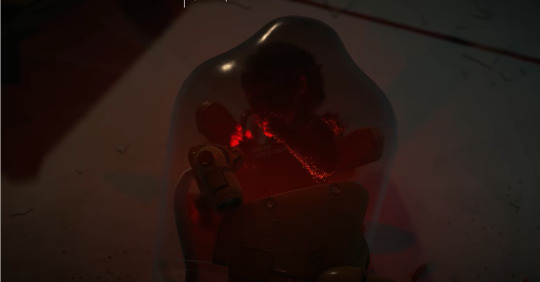
After (presumenbly) beign shot by an unkown soldier, we see in a flash of red light a bb appearing in a pod - and they have angel wings, just like the baby shown previously had on her (cute) outfit
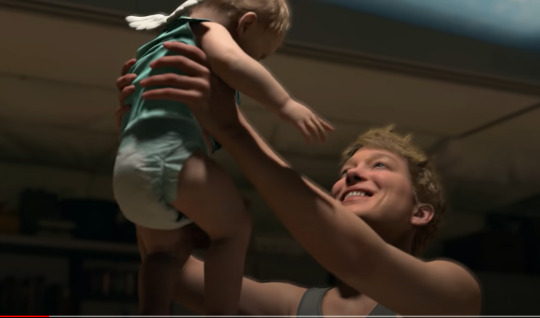
And this baby is safely confirmed as lou, as she has that emborided in her thingy too
(i would put a screenshot here but i cant get a good capture for it - sorry)
Now, the elephan in the room - fragile has lost her scars? That's really weird. There is not enough information to say why is that, but i think it's notable to note that it's implied timefall has stopped after sam "defeated" amelie, as we see normal rain falling down in the ending. Or maybe that was timefall and that's why sam's hair is gray like that... but let's not get ahead of ourselves.
I think hideo will just pull some deus ex machina out of his ass that fixes timefall's effects. One i came up with myself was the idea of new reverse timefall, which reverses time - seems random but so does her younger body. I just hope it's gonna be explained in some capacity.
One common theory is that it's not actually fragile and it's older lou - that's dumb and im not gonna dwell into that. Moving on...
Cultists!

I fucking love cultists in video games. Not sure why? The vibes just click for me, i love a lot of weird video game shit. Im presuming that they are tied to higgs, since the ones we see on the end look vaugley the same with the red motife, but i guess i could be wrong.
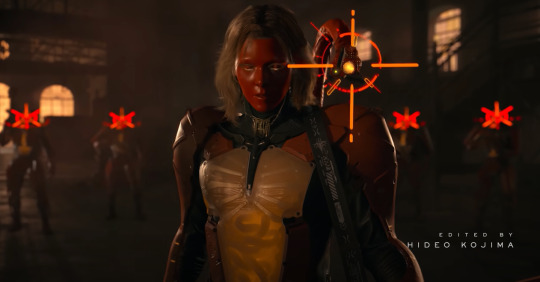
Focus on them seems interesting, since DS never much focused on terrorists. Sure, higgs was a major antagonist which was a looming threat but the homo demens AS A GROUP was just cannon fodder and we dont even really see what they... do? What is their agenda, why they did they join higgs, what do they want, exacly? I really hope this focus in the trailer means that they are gonna be a bigger part of the story. The very idea of mules and demens where so cool and i loved fighting them.
But back to the cultists themselves. They seem to worship amelie, same with higgs. he has amelie hair with a mask of her face, the group has a thingy with her visage on it.
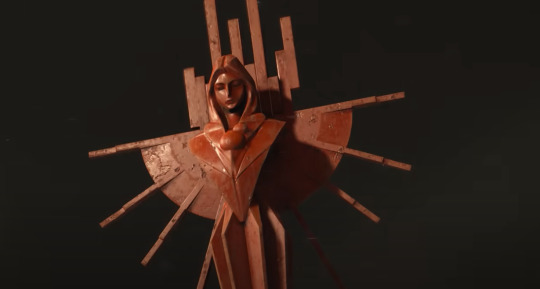
So, after learning of exticnion enteties higgs gathers some pepole to start a group to bring on the apocalyplse as some sort of death cult. But that doesnt make much sense, does it?
In the diary of higgs after his exile he seems pretty sad and remoursfull, understanding he was simply played by amelie to fuel her needs, thiking of himself as a stupid man blinded by a stupid goal. Doesnt sound like someone planning revenge to me.
So i dont think this is higgs - at least not entirely. Kojima loves his body doubles, repeated actors and scenarios to fuck with your expecations. I don't have any theories about that, but i do think it's probablly not fully him. Becuse lets be honest, how would he escape from that beach in the first place?
Now my favourite part to think about - fragile and her crew. And their cool as fuck ship.
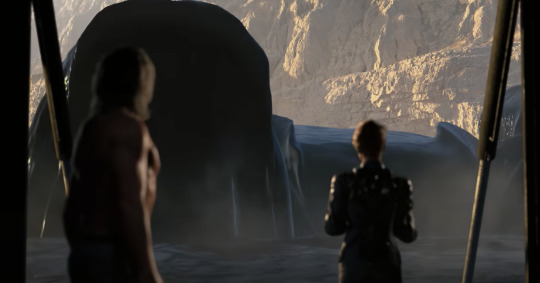
It's a submarine. It comes from the tar, which is stated to be infittly deep and it has a sea monster logo on it. This is so fcking cool! I hope it's gonna be like the aac in mgsv, where you can have a mobile base to plan out your operations and fast travel around the map. We did have that kinda with the private rooms, but i feel they where a bit lacking. A mother-base type ship in death stranding where you can go around, talk to characters and maybe do some side mission stuff.... im smiling at the very thoughts, and i hope this is what kojima is going for with this. That would be so fucking cool!!!!!!!!!!!!
Oh, and maybe the whale dream added in the directors cut was supposed to tease this - underwater exploration. Shits cool as fuck.
Drawbridge.

"both stick and rope, to protect and connect. together, for tommorow"
This ties to the common belief that ds2 will focus more on action and combat. its not stick vs rope anymore, it's both of them together, working as tools in an union. could tie with the tagline at the end - world has been connected now by bridges, so now they have to "protect it". changing the uca into a dystopia, maybe? would be boring.
One thing i have yet to see mentioned about the logo is that it looks like an umbrella, which is an obvious fragile connection.
Oh hey sam appears here too - not much to say about him other then he is way older then he should be, but we have simple in-universe phenomana which can cause this so. not much to talk about here imo. cool he's back - where the fuck is deadman tho...
"It wasn't the UCA that made the final decision. It was APAC. A private corporation." obvusly related to one of the logos kojima teased.

I can't think of any decision the uca has made - only thing that comes to mind is the bb project, but idk, doesnt fit to me. The logo looks like a compas, which could tie into the submarine/ship shown earlier. "automated public assistance" is such mgs speak, it doesnt make sense and doesnt mean anything, what is public assistance? Like, security? Could make sense with the drawbrige thing about using protection and stick + ropes. Automated... like robots? Like the technology uca uses? It's all so vauge and not giving much anything, but the fact it's inlcuded in the picture teaser AND the trailer must mean its someting very important to the story of the game. Can't glean much else...
And that's the trailer! I think i gave my thoughts on everything in the teaser that came to mind. But now, let's hear some... baseless speculation, yippe!!!
I think kojima will be pulling a mgs2 and sam is not gonna be the main character. Well, he may be, but i think we will be playing as someone else too. Sam is older, his story is kinda finished at this point. Addition to elle manning who was fthe first person teased for the project who we have yet to appear in the actual trailer BUT was present at the VGA. With her placement on the poster pepole speculate she's gonna be older lou - its possible.

(look at her heart brithmark, appearing right in the middle of ellies name!)
But i think it very much just be that kojima was saving all norman reedus promotion for later to give a bigger suprise. But even if it's not lou i bet we're gonna play as her. Could be cool!
There where many speculation how higgs is back, i touched upon one earlier, but i liked the theory i saw about him possesing amelie. Would explain the different hair, outfit, the mask... higgs somehow got control over her and her powers and uses them for his benefit. We have so little info it's as plasubale as any other theory you can come up with.
Lou transforms into some tentacle thing, and we saw before that bts can appear as sea monsters and are ocean themed - is she becoming a bt? We kinda saw her die... kinda, becuse she's back in the pod. Eh.
I could speak about a ton of things now since i am a weirdo who has lots of thoughts, but the main thing i wanna say is higgs's new getup looks organic. Look at his odradek, it looks more like a tentacle then a robot arm- it's weird, it's lumpy, it moves very naturally... is he mutating or something? Is it the same thing that's happening to lou? Maybe beach exposare causes some effects to the body...
And that's it i guess! I could probablly say much, much more BUT this post is going on waaaaaay too long and i think i already tocuhed on all the main thoughts i wanted to addres, and the rest would be just me looking at all the extremly little details and saying "oh hey that's there. it probablly means something" and i think that type of writing would be too borning!
AND ALSO I SPENT THREE LESSONS WRITING THIS AND I HAVE A THINGY TO WRTIE FOR SCHOOL NOW LOL.
Anywya feel free to write your thoughts in the notes, i will gladdly read yalls speculation! i love reading that shit! you guys are amazing!
STRANDHEADS ROLL OUT!
22 notes
·
View notes
Note
Hi! If it's not difficult for you, answer my question too!
What is your fluffiest Rivamika head canon and what is your most angsty Rivamika head canon?
Hi Anon !
Thanks for you question, I will do my best to answer it. Don’t hate me…
My fluffiest Rivamika headcanon :
Levi is the only one who succeeded in making Mikasa laugh. It only happened once and it wasn't a big laugh, more of an amused chuckle but it was the closest to a laugh you could hope for from a sober Mikasa. And besides, Levi is very bad at telling jokes so Mikasa is also the only one who at least chuckled in amusement rather than laughing in nervousness or embarrassment at one of the rare jokes he knew and with a particular humor.
Levi won't admit it but he might have felt a little flattered and curious… He will then try to repeat the feat a few times but without success. Until he was SO bad that he managed a second time to make Mikasa chuckle… Even if it was in a mocking way, the black irises were shining and the sound sweet wasn't really unpleasant, he decided that it might be worth it a little.
My angsty Rivamika headcanon :
Even though Levi was offered to return to Paradise, he always refused. One of his reasons was that he was a little uncomfortable seeing Mikasa again, even taking the risk of it. As proud and impressed as he was when she decided to sacrifice the person who was dearest to her for the sake of humanity, he still can't help but feel a little guilty… The news of Mikasa that Armin gave him (thanks to the letters that he exchanged with her) didn't help. Although she claims to be fine, they all know her well enough to guess that she hasn't grieved yet. Levi can well imagine her spending her days at Eren's grave… neglecting herself, not eating properly, not caring about her appearance... it had already been seen in the past, he had never liked this image and still doesn’t like it. If only he had been in better shape, he should have been the one to kill Eren, as he had promised at the court... Mikasa might have hated him for it, but it might also have given her the strength to really move on, perhaps more easily. And above all, he would have spared his subordinate from this terrible burden…
A few years or decades (whichever you prefer) later, Onyankopon informed Mikasa that Levi had died and that he had designated her as his heir. It was a little strange because they hadn't seen or spoken to each other since Eren's death... She had only heard from him briefly through Armin's letters. Although she didn't understand Levi's decision, she went to the Continent, discovered where he used to live. He had left behind only a few things, some clothes, books, a tea set and his 3DM equipment... nothing really valuable, naming her was symbolic, she understood. Onyankopon, Gaby and Falco had taken care of him… But Onyankopon confirmed the feeling she had, despite the fact that Levi seemed to have had a peaceful life here, he seemed a bit empty and lonely despite their company. So Mikasa decided to repatriate Levi's body. She gave him a simple, intimate and neat funeral. She didn't forget to tie his emblematic necktie around his neck before burying him next to Erwin, under the name of Levi Ackerman.
She visited Levi's grave at least once per month to keep it clean. And each time, she couldn't help but feel a certain regret for letting him die alone on a foreign land. Not to mention all the things they hadn't talked about or said to each other…
Et voilà ! I hope my answer was interesting and relevant. I tried to stay realistic since for me a headcanon has to be plausible with the canon. So I tried to write two headcanons that can fit with all the ways you can ship Levi and Mikasa (love, friendship, comrades...etc)
If this question inspires you, I'd love to read your fluffiest and angsty headcanons in a comment or post (please tag me so I can see and read them). Also feel free to tell me what you think of mine. 😉
22 notes
·
View notes
Text
I wrote about this a couple of days ago but I deleted it. It’s really personal. I’ve had two close members of my family die very close to members of the royal family. So this is about death, respect, and dignity, the difference between us and them, and all of this with the queen has brought up a lot of stuff for me and I have nowhere else to vent.
In June 1997, my Grandad died. He’d just retired and was on his first retirement holiday with my Nan. On the final day, he had a massive stroke. Two days later, he died. He wasn’t ill at all. He was a fit man. It came as a massive shock to us all and we all felt so lost because my Nan was alone.
My two single aunties landed in the country just after he died. The govt of the country looked after my family incredibly well and with all the sensitivity that was needed. They gave my nan and aunts lots of support. Everything to do with my Grandad’s death on their side was handled impeccably.
Then came his repatriation.
Our govt wanted my Grandad to be cremated in the country because there was lots of red tape with bringing him home. My nan stood firm. We’re a huge family and the funeral needed to be at home. Because of superstition, my grandad had to be put on a commercial flight during the dark so that nobody would see. He was transported in a tin box, hidden in the plane. Nobody could know he was there except the people who would meet him. He was taken off the plane in the dark, again so he wouldn’t be seen. When he came home, my mum couldn’t say goodbye to her dad on advice of the undertaker because the air pressure had damaged him so badly. It further broke our hearts. It felt like he’d been treated as a piece of meat rather than a loved person. All of this took over two weeks to happen because of all sorts of stuff this govt’s end, and then we had to go through lots more stuff to do with the coroner’s court.
Fast forward a couple of months and Princess Di died and she is bought home within a couple of days. Because she was the mother to an heir to the throne, she was given all these bells and whistles and dignity. She was not hidden in a plane in a tin box. I was 13 at the time and it infuriated my how just by design of birth and marriage someone was treated with a dignity and respect that my family were not afforded.
I went back to school and a few weeks later a friend had a letter from William and Harry to thank her for writing to send her condolences. Over the summer, a friend of mine had lost her dad. She asked this other friend of ours where he condolenses were to her. The monarchist friend basically said that our friend wasn’t royalty so it didn’t matter. I don’t come from a monarchist family, but it cemented in me my distaste for them.
Fast forward 25 years and 3 weeks ago my father-in-law died. We thought it was a peaceful death after he had developed pneumonia after having covid. We assumed that everything would be sorted as soon as it possibly could. His body has only just been released because the coroner has been having trouble getting responses from doctors with help. So an inquest has now got to happen. My husband is not only devastated in grief, but now he’s got on top of that the stress of not know when his father will be cremated for him to be returned to Ireland. But then there’s the Queen. From ten days of her death, she will have her funeral. Again, she is being treated with respect and so many other people are not in their death.
And then there are people saying they feel like they’ve lost a member of their family. I remember people wailing when Diana died and thinking they surely must have no idea what it’s like to lose a loved one because how does it compare? How does that compare to me losing my beloved grandad? And now I’m seeing it all again with people sobbing about the queen and here is my husband who has actually lost his dad.
I know this is really personal and I wish this place had filters like old LJ lol. I feel thankful that I have a dash full of people who feel the same way as I do about monarchy. I don’t know how I’d cope if I didn’t. The stuff you’ve been reblogging has really brought a smile to my face during this horrible time for us.
23 notes
·
View notes
Text
A national treasure is a cherished side character; they are never at the centre of events, and are, endearingly, never the holder of secular powers. They stand around the edges of a ruling class’s mental universe: observing, warning, guiding, admonishing – sometimes obliquely, sometimes not. They act as the conscience of a nation, or, rather, as the conscience of its rulers.
...
If we look at it this way, then the first ever British national treasure was Edmund Burke, famous for his Reflections. Burke was principled; Burke was conscientious; Burke was solemn; Burke was worthy; Burke never achieved a higher office than Paymaster of the Forces – a minor clerical job. Nevertheless, especially in the decade after his death in 1797, Burke could be cherished as the burning conscience of his society. Impossible to deal with as a man, but, nevertheless, part of the furniture. The immediate inheritor of this role was one of Burke’s contemporaries: William Wilberforce, the apostle of Victorianism, and the scourge of English popular customs like bear-baiting, bull-baiting, and boxing.
...
The suite of characteristics that makes up a national treasure lends itself to two archetypes, both forces for conservatism: the bureaucrat, and the light entertainer. So it has proven. Bruce Forsyth; David Frost; Stephen Fry; Betty Boothroyd; and latterly, Jackie Weaver, Lindsay Hoyle, and Sue Gray. All have been drawn from either of these two wells, and have led their lives accordingly.
The trouble is that Britain’s governing classes, especially after 1997, have begun to insist more and more strongly on these qualities: more rule-bound; more solemn; more strivingly modest. These characteristics, once endearing in their own way, have now started to ferment. Increasingly, the only individuals who would ever consent to play this role are either second-rate or suspect.
...
By the early 2020s, the standard British national treasure is an entertainer and informer, a bursar of charitable millions, a practitioner of old-fashioned mannerisms, who maintains a special relationship with the House of Windsor. This model – startlingly – remains the same basic one established by Jimmy Savile.
...
Meanwhile, the social importance of these people is evermore emphasised by England’s ruling classes. One refrain about Elizabeth II was that she, in her person, ‘held together’ 21st Century Britain: the same has been said of David Attenborough and Captain Tom Moore. This kind of hysteria has no foreign analogue; in the United States, Tom Hanks and Dwayne “The Rock” Johnson are not assigned such a role in the body politic.
Louder also is the insistence that we like these people. My first visceral experience of this was when I was informed in a series of adverts that I loved Phillip Schofield, a television presenter of little distinction. As we have seen, these people are not for our consumption. It is therefore of little surprise that they seldom inspire any real popular love. Stephen Fry and Sandi Toksvig are not liked, only obeyed. There is a garrison quality to these national treasures. Beyond their core constituency of public sector employees, popular opinion on these people ranges from sullen indifference to outright hostility.
2 notes
·
View notes
Text
The Ultimate Checklist for Repatriation of Remains: Ensuring Dignity in Death
Dealing with the loss of a loved one is a profound challenge, especially when navigating the repatriation of remains back to their homeland. This process often involves understanding complex entry requirements, obtaining a death certificate, and ensuring the dignity of the deceased is maintained throughout.
Our guide simplifies the repatriation process, providing you with essential information on cultural affiliation, legal documentation, and the steps necessary to bring your loved one home with respect and honor.
Understanding the Repatriation Process
Definition and Scope
The repatriation of remains involves complex procedures that ensure the dignified return of a deceased's body to their homeland. This process is governed by specific legal frameworks and cultural protocols that vary significantly from one country to another. It encompasses everything from the initial notification of death to the transportation and final handover of remains to the family or local authorities.
Legal Requirements and Documentation
Navigating through the legal landscape is a critical component of the repatriation process. The necessary documentation often includes a death certificate, a consular mortuary certificate, an affidavit from a local funeral director, and a transit permit. These documents serve multiple purposes, such as confirming the cause of death, ensuring the remains are handled respectfully, and facilitating smooth passage through customs. It is imperative to have these documents properly authenticated and, if necessary, translated to meet the requirements of the involved countries.
Roles of Different Agencies
Multiple agencies play pivotal roles in the repatriation of remains. Local consulates or embassies guide the process by liaising with domestic and foreign governmental bodies, ensuring all legalities are adhered to according to the respective laws. Funeral homes and repatriation services provide logistical support, handling the preparation and transport of the body. They coordinate closely with airlines and shipping companies, which have specific regulations for transporting remains. Understanding each entity's responsibilities is crucial for a smooth and respectful repatriation process.
Emotional and Cultural Considerations
The Emotional Impact of Loss
The journey through grief is profoundly influenced by cultural contexts and individual experiences. Native American communities, for example, view cultural items such as pottery, weapons, and sacred objects not just as artifacts but as vital parts of their heritage and spiritual practices. The theft or destruction of these items can exacerbate the grief experienced by these communities, as these acts are not only a loss of physical items but a deep severance from their cultural and ancestral connections. This underscores the complex layers of loss that go beyond the physical and touch on the spiritual and communal.
Cultural Practices and Beliefs
Respecting Sacred Traditions: Many cultures, including Native American and Indigenous groups, have specific rituals and practices associated with death that are crucial for honoring the deceased and providing closure to the community. For instance, the repatriation of cultural items and ancestral remains is seen not just as a legal obligation but as a moral one that is deeply intertwined with cultural revival and healing.
Consultation and Consent: Institutions like the Museum of Us engage in extensive consultations with descendant communities to ensure that the repatriation process respects cultural sensitivities and supports the community’s ongoing efforts to reclaim and revitalize their traditions. This includes working with tribal leaders, cultural experts, and community members to ensure that each step of the process is handled with care and respect.
Recognition of Cultural Affiliation: Establishing a clear line of cultural affiliation through evidence and consultation helps in appropriately returning cultural items and remains. This not only supports legal and ethical compliance but also fosters a sense of justice and acknowledgment of historical wrongs, aiding in the communal healing process.
By integrating these practices into the repatriation process, we honor the emotional and cultural dimensions of loss, acknowledging that each community has unique needs and traditions that must be respected and upheld.
Logistics of Repatriating a Body
Certification and Embalming
To ensure the dignified handling of your loved one's remains, specific certification and embalming processes are often necessary, particularly when transporting across international borders. If the cause of death was a quarantinable communicable disease, you might need to contact the U.S. embassy or consulate for assistance. Typically, the necessary documents include a consular mortuary certificate, a local death certificate, an affidavit from a local funeral director, and a transit permit. Embalming may not be required if the remains are transported in a leakproof container, but it is subject to the destination country's regulations.
Transportation Arrangements
Organizing the transportation of human remains requires coordination with various authorities and adherence to strict regulations. You'll need to choose a funeral home or repatriation service experienced in international transportation. They will help with embalming or cremation, securing necessary permits, and arranging transportation. It's essential to ensure the remains are placed in a suitable container that meets airline or postal service requirements. The funeral home typically handles negotiations with airlines, which require them to be a "known shipper."
Costs and Financial Assistance
The cost of transporting human remains internationally can vary significantly, ranging from as low as $300 for cremated remains to over $20,000 for a casket. These costs depend on the transportation method and the origin and destination countries. For financial assistance, you might explore options such as repatriation loans, which are typically used for immediate medical expenses but can also cover transportation costs in certain circumstances. It's advisable to consult with consular officers who can provide guidance on minimizing expenses and navigating international regulations effectively.
Legal and Ethical Issues
Local vs. International Laws
Navigating the complexities of local and international laws is crucial when repatriating remains. For instance, laws like the International Air Transport Association (IATA) guidelines dictate the transportation procedures of human remains, covering aspects from packaging to documentation. Moreover, each country may have its own customs regulations and health standards that affect the repatriation process. It's vital for families and service providers to understand these legal frameworks to ensure compliance and avoid delays or legal complications.
Ethical Considerations in Handling the Deceased
Respecting the deceased transcends mere legal compliance; it involves deep ethical considerations. For example, the Native American Graves Protection and Repatriation Act (NAGPRA) in the United States mandates the return of Native American human remains and cultural items, reflecting a commitment to cultural dignity and ethical repatriation. Similarly, the handling and eventual repatriation of remains should honor the deceased's community's cultural and religious practices, ensuring that these sensitive processes are conducted with the utmost respect and integrity.
Conclusion
Through exploring the multifaceted landscape of repatriating a loved one's remains, we've delved into the crucial steps, legal necessities, and the significant emotional and cultural considerations that accompany this delicate process. We underscored the importance of navigating legal requirements, engaging with various agencies, and honoring cultural and emotional nuances to ensure the dignified handling and transportation of remains across borders. The journey of repatriation, fraught with its complexities, stands as a testament to the respect and honor we seek to uphold in the face of loss, emphasizing the utmost care in dealing with such sensitive matters.
The implications of this exploration reach beyond the logistical and legal frameworks; they touch upon the profound respect and acknowledgment owed to the deceased and their communities, bridging the gap between legal obligations and cultural sensitivity. As we conclude, it is our hope that this guide not only serves to assist those tasked with the heavy responsibility of repatriation but also sparks further discourse on improving and empathizing with the emotional and cultural aspects of this process. Recognizing the need for continued dialogue and improvement in policies is crucial, as it underlines our collective commitment to dignity in death, transcending borders and cultural divides.
FAQs
1. What documents are necessary for end-of-life planning?To prepare for end-of-life decisions, it is important to have advance directives such as a living will and a durable power of attorney for health care. A living will specifies your preferences for medical treatment if you are unable to make these decisions yourself, while a durable power of attorney for health care allows someone else to make health care decisions on your behalf.
2. What steps should be taken immediately following the death of a loved one?In the first two weeks after a loved one's death, several important steps need to be taken:
Locate and submit the deceased's will to probate court.
Find any trust documents and insurance policies.
Contact an attorney, financial advisor, and tax advisor.
Seek legal and tax advice for yourself.
Forward the deceased's mail.
Notify the Social Security Administration of the death.
3. What does repatriation of human remains involve?Repatriation of human remains involves transferring the deceased from a foreign country back to their homeland. This process is usually undertaken to ensure that the final rites and ceremonies can be performed in their native place.
4. How can I organize my personal affairs effectively?Organizing your personal affairs involves several key steps:
Take an inventory of all your personal belongings.
Create a last will and testament to outline the distribution of your assets.
Choose a trusted person to act as the executor of your estate.
Consider setting up a living trust to manage your assets.
Establish a power of attorney to handle your financial and legal matters if you become incapacitated.
Write a living will to document your wishes regarding medical treatment.
Prepare for any potential estate taxes.
Ensure your digital assets are accounted for and managed.
0 notes
Text
Biopower, Funeral Rituals and Last Rights
A key aspect of Michel Foucault’s theory of biopower is death and the state’s power to kill. One of the key examples cited when discussing Foucault’s theory is genocide and the ultimate power the state has over the body. However, this power over the body extends even further. The state not only has the power to kill, but also the power to control what happens to the living after a loved one dies.
In Vincent Brown’s book documenting the Atlantic slave trade in Jamaica, he writes extensively about the cultural practices of enslaved Africans surrounding the dead. Specifically, he stresses the importance of Last Rites and funeral rituals. These Last Rites and other rituals separate the living from the dead and were an important part of the grieving process for enslaved Africans during this time. He discusses at length about how proper care for the dead validates the humanity of the person; something enslaved Africans were stripped of by white plantation owners (2010).
Proper care for the dead looks very different across cultures, but is regardless of importance to everyone. Many peoples across the globe believe that proper burial rituals are not only an expression of honor and respect for the person, but also ensure the smooth transition of the spirit/breath/soul etc. to the next life. White settlers have notoriously demonized funeral practices of Indigenous peoples and enslaved Africans alike (Brown, 2010). The harm perpetuated by white settlers to Indigenous/African funeral practices is exacerbated by the looting of funerary objects and human remains from grave sites.
Museums across the nation still hold funerary objects–and even actual people–within their walls. Often, these sacred objects are locked away in boxes, waiting to be cataloged. Although federal law mandates that museums must return Indigenous artifacts to their rightful owners under the guidelines of NAGPRA, many objects still remain without their rightful owners (Atalay, et al. 2017). The removal of these sacred objects from graves prevents many Indigenous people from properly grieving and caring for their ancestors. The destruction of funeral practices is an example of how biopower persists even after a person is dead.
References:
Atalay, S., Shannon, J. A., & Swogger, J. (2017). Journeys to complete the work: Stories about repatriations and changing the way we bring Native American Ancestors Home. University of Massachusetts.
Brown, V. (2010). The reaper’s garden: Death and power in the world of Atlantic slavery. Harvard University Press.
0 notes